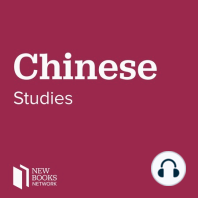89 min listen

Brenton Sullivan, "Building a Religious Empire: Tibetan Buddhism, Bureaucracy, and the Rise of the Gelukpa" (U Pennsylvania Press, 2020)
Brenton Sullivan, "Building a Religious Empire: Tibetan Buddhism, Bureaucracy, and the Rise of the Gelukpa" (U Pennsylvania Press, 2020)
ratings:
Length:
72 minutes
Released:
Apr 22, 2021
Format:
Podcast episode
Description
How did Geluk Buddhism become the most widespread school of Tibetan Buddhism in Inner Asia and beyond? In Building a Religious Empire: Tibetan Buddhism, Bureaucracy, and the Rise of the Gelukpa (University of Pennsylvania Press, 2020), Brenton Sullivan reveals the compulsive efforts by Geluk lamas and "Buddhist bureaucrats" (bla dpon) in the early modern period to prescribe and control a proper way of living the life of a Buddhist monk and to define a proper way of administering the monastery.
Using monastic constitutions (bca' yig) and rare manuscripts dating primarily to the eighteenth century collected from research trips to Tibet and Mongolia, Sullivan shows that Geluk monasteries regulated scholastic curricula, liturgical sequences, financial protocols, and so on. These documents also appeal to notions of "impartiality" and "the common good," revealing a kind of preoccupation with rationalization and bureaucratic techniques normally associated with state-making.
Sullivan points out that unlike with leaders of other schools of Tibetan Buddhism, Geluk lamas devoted an extraordinary amount of time to the institutional framework within which aspects of monastic life would take place. He argues in Building a Religious Empire that "this privileging of the monastic institution fostered a common religious identity that insulated it from nationalism along the lines of any specific religious leader, practice, or doctrine."
Sullivan also reminds us that the remarkable success of Geluk Buddhism's spread to various places in Inner Asia can also be attributed to the mobility of monks and lamas, which "both ensured a degree of uniformity among Geluk monasteries and was facilitated by that uniformity." This mobility facilitated the creation of a system of overlapping networks and loyalties that collectively made up the Geluk school across Tibet and Mongolia. Mobility was also an important part of the Geluk lamas' administrative duties. Sullivan identifies that the Geluk school was "polycephalous," or "multi-headed," and "hydra-headed" at the same time, for it did not rely on a single lama or monastic seat for promoting and maintaining its teachings and organization but on a proliferation of such lamas in various monastic centers that are also regenerative.
Daigengna Duoer is a Ph.D. student at the Religious Studies Department, University of California, Santa Barbara.
Learn more about your ad choices. Visit megaphone.fm/adchoices
Support our show by becoming a premium member! https://newbooksnetwork.supportingcast.fm/chinese-studies
Using monastic constitutions (bca' yig) and rare manuscripts dating primarily to the eighteenth century collected from research trips to Tibet and Mongolia, Sullivan shows that Geluk monasteries regulated scholastic curricula, liturgical sequences, financial protocols, and so on. These documents also appeal to notions of "impartiality" and "the common good," revealing a kind of preoccupation with rationalization and bureaucratic techniques normally associated with state-making.
Sullivan points out that unlike with leaders of other schools of Tibetan Buddhism, Geluk lamas devoted an extraordinary amount of time to the institutional framework within which aspects of monastic life would take place. He argues in Building a Religious Empire that "this privileging of the monastic institution fostered a common religious identity that insulated it from nationalism along the lines of any specific religious leader, practice, or doctrine."
Sullivan also reminds us that the remarkable success of Geluk Buddhism's spread to various places in Inner Asia can also be attributed to the mobility of monks and lamas, which "both ensured a degree of uniformity among Geluk monasteries and was facilitated by that uniformity." This mobility facilitated the creation of a system of overlapping networks and loyalties that collectively made up the Geluk school across Tibet and Mongolia. Mobility was also an important part of the Geluk lamas' administrative duties. Sullivan identifies that the Geluk school was "polycephalous," or "multi-headed," and "hydra-headed" at the same time, for it did not rely on a single lama or monastic seat for promoting and maintaining its teachings and organization but on a proliferation of such lamas in various monastic centers that are also regenerative.
Daigengna Duoer is a Ph.D. student at the Religious Studies Department, University of California, Santa Barbara.
Learn more about your ad choices. Visit megaphone.fm/adchoices
Support our show by becoming a premium member! https://newbooksnetwork.supportingcast.fm/chinese-studies
Released:
Apr 22, 2021
Format:
Podcast episode
Titles in the series (100)
Timothy Brook, “The Troubled Empire: China in the Yuan and Ming Dynasties” (Harvard UP, 2010): Tim Brook‘s The Troubled Empire: China in the Yuan and Ming Dynasties (Belknap Press of the Harvard University Press, 2010) rewards the reader on many levels. Though it provides an excellent introduction to Yuan and Ming history for both students and a... by New Books in Chinese Studies